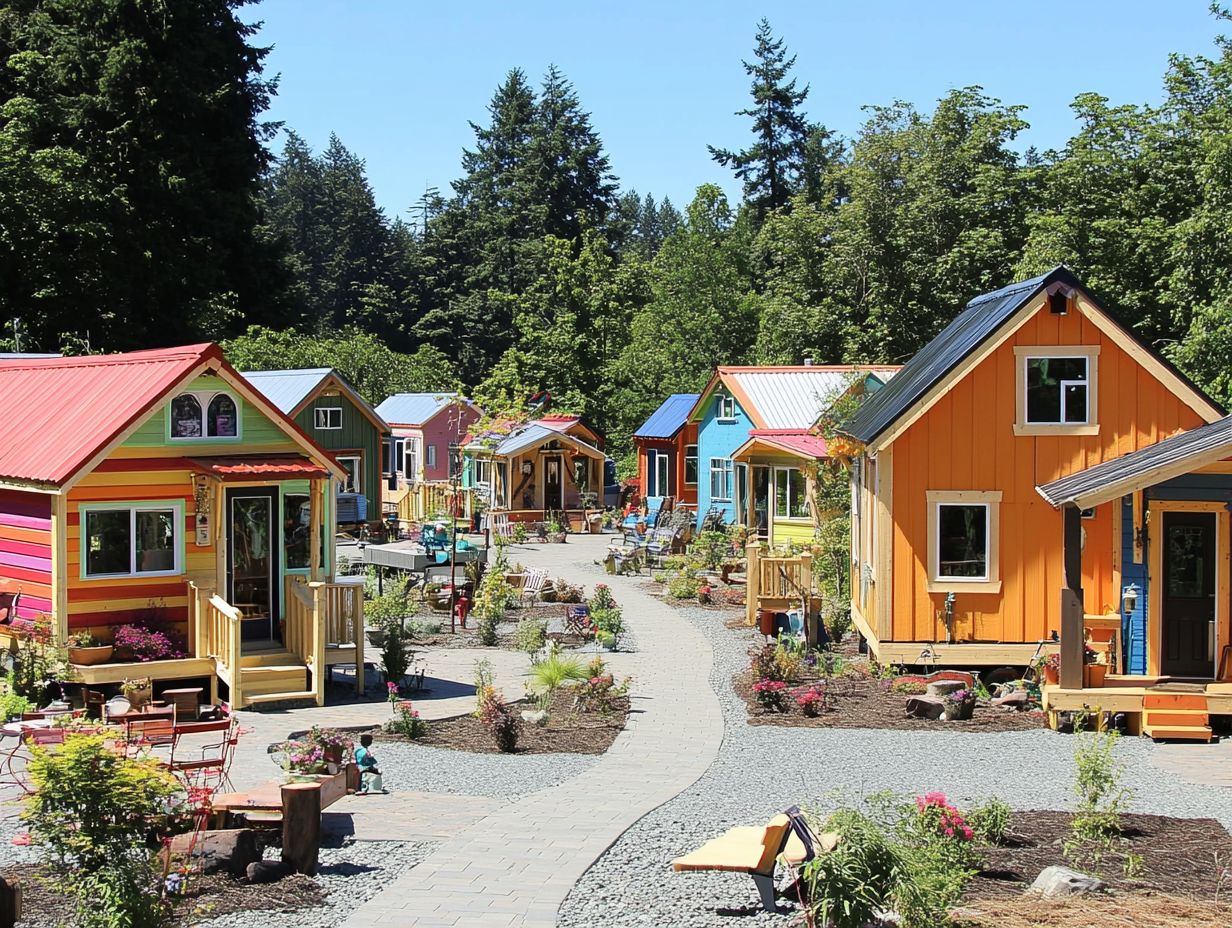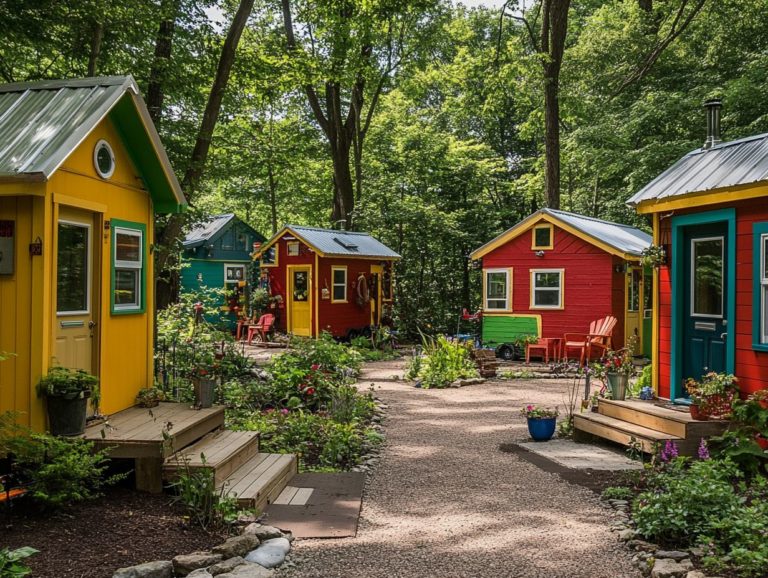Finding Affordable Tiny House Communities
Tiny house communities are a growing trend in eco-friendly living, offering sustainable and cost-effective solutions.
This article delves into the myriad benefits of residing in these close-knit neighborhoods, providing significant cost savings and the invaluable support of fellow residents. It highlights essential factors to consider when selecting a community, such as location and amenities.
You ll find helpful tips on how to discover affordable options and explore creative financing solutions that can turn your tiny house dream into reality. Dive in to uncover how tiny house living can elevate your lifestyle!
Contents [hide]
- Key Takeaways:
- Benefits of Living in a Tiny House Community
- Factors to Consider Before Choosing a Community
- How to Find Affordable Tiny House Communities
- Financing Options for Tiny House Communities
- Frequently Asked Questions
- What are some ways to find affordable tiny house communities?
- Are there any specific locations known for affordable tiny house communities?
- How can I determine if a tiny house community is affordable?
- What are some potential challenges in finding affordable tiny house communities?
- Are there resources or organizations that can help with finding affordable tiny house communities?
- Can I build my own tiny house in an affordable tiny house community?
Key Takeaways:

- Tiny house communities offer cost savings and a strong sense of community support.
- When choosing a community, consider factors such as location, amenities, and community rules.
- Use online resources and networking to find affordable tiny house communities and explore creative financing options.
What are Tiny House Communities?
Tiny house communities are a growing trend in eco-friendly living, seamlessly blending minimalist lifestyles with a vibrant community spirit. Within these eco-villages, you ll find shared amenities like community gardens and walking paths, perfect for cultivating relationships while reaping the rewards of affordable homeownership.
Here, the focus isn t just on downsizing; it s about embracing a lifestyle that aligns with awareness of our impact on the environment and the ideals of modern tiny living.
In these distinctive neighborhoods, homes are thoughtfully designed, typically ranging from 100 to 400 square feet, showcasing innovative architectural features that maximize both space and functionality. Take Acony Bell Tiny Home Community in Mills River, North Carolina, for instance. This charming locale exemplifies the ethos of tiny living and is part of tiny house communities: a sustainable living option, inviting residents to embrace a slower pace of life amidst nature.
On the other hand, Cedar Springs Tiny Village in Ohio radiates a welcoming atmosphere, allowing individuals from varied backgrounds to connect and engage in community projects. Such environments not only shrink environmental footprints but also foster a deep sense of belonging, transforming neighbors into friends and creating a supportive network built on shared values, as highlighted in the rise of tiny house villages.
Benefits of Living in a Tiny House Community
Living in a tiny house community is exciting and packed with benefits, from affordability to an enriching sense of camaraderie. These eco-villages foster a strong community spirit while offering shared amenities like community gardens, charming local coffee shops, and inviting common areas.
These features enhance social interactions among residents and champion sustainable living practices, creating a lifestyle that is both fulfilling and environmentally conscious.
Cost Savings and Community Support
One of the primary advantages of living in a tiny house community is the remarkable cost savings you can enjoy. Emphasizing affordable homeownership lightens your financial load and cultivates a supportive network where fellow residents uplift each other in maintaining sustainable living practices.
These savings become evident in lower utility costs, as your smaller space demands significantly less energy for heating and cooling, leading to more manageable monthly bills. Many tiny house communities also benefit from reduced property taxes, further alleviating financial stress. The shared ethos of community support strengthens resilience among members, fostering an environment where you can rely on each other for resources and expertise. Additionally, tiny house communities promote building new friendships that enhance this sense of belonging.
For instance, thriving tiny house communities often launch cooperative initiatives like shared gardens or tool libraries, solidifying bonds while championing eco-friendly practices that nurture both the community and the environment.
Are you ready to discover the joys of tiny living? Start your tiny house journey today!
Factors to Consider Before Choosing a Community

Selecting the ideal tiny house community requires thoughtful consideration of various factors, such as location, amenities, and community regulations. Also, check if the community has a pet-friendly policy.
As a prospective resident, you should assess how these elements resonate with your lifestyle preferences and commitment to sustainable living. This ensures that the community will meet your needs and enrich your overall quality of life.
Location, Amenities, and Community Rules
The location of a tiny house community is pivotal in shaping your lifestyle. Accessibility is essential, while the amenities offered can significantly elevate your living experience.
Understanding the community rules is key to making sure you’ll thrive in your new home! For instance, if you find yourself drawn to rural settings like Bluegrass Tiny Ridge in Central Kentucky, you can enjoy expansive outdoor spaces and a serene environment, perfect for those seeking a peaceful retreat. Additionally, you might explore living off-grid in tiny house communities to enhance your experience.
On the other hand, if urban life appeals to you, communities like ESCAPE Tampa Bay in Florida provide the excitement of city living, complete with easy access to public transportation and local attractions.
These communities often boast shared amenities like communal gardens, workshops, and recreational areas, fostering a sense of belonging. However, specific rules may differ; some communities promote eco-friendly practices, while others prioritize a close-knit atmosphere. It’s crucial to align with these guidelines as you consider your potential new home.
How to Find Affordable Tiny House Communities
To find affordable tiny house communities across the United States, you ll want to tap into a variety of online resources and connect with like-minded individuals passionate about sustainable living.
By leveraging these tools, you can uncover eco-villages sustainable living communities focused on eco-friendly practices that resonate with your values and fit within your budget. Additionally, learning how to choose the right tiny house community will help you start your journey toward affordable homeownership in locales like Lakeside, Arizona or Mount Laguna, California.
Online Resources and Networking
Leveraging online resources is essential for anyone seeking a tiny house community. These platforms offer a wealth of information and networking opportunities. Websites dedicated to sustainable living and tiny house listings can serve as invaluable tools.
Platforms like the Tiny House Forum and Tiny House Talk are treasure troves where enthusiasts exchange insights about affordable communities. Engaging with social media groups on Facebook or Reddit enables you to connect with others who share your aspirations, and learn about the importance of sustainability in tiny house communities.
By interacting with like-minded individuals, you can gain valuable recommendations and experiences that can make your transition much smoother. Networking often reveals hidden gems in tiny house communities that remain under the radar, offering both affordability and a supportive atmosphere crucial for the tiny house lifestyle.
Financing Options for Tiny House Communities

Navigating financing options for tiny house communities can feel daunting. However, a range of creative solutions exists to help make affordable homeownership a reality.
Grasping these options is essential as you embark on the journey toward joining a tiny house community and exploring the benefits of living in a tiny house community while fully embracing the principles of sustainable living.
Creative Financing Solutions
Creative financing solutions are vital for achieving your dream of affordable homeownership in tiny house communities. These options vary widely, offering diverse pathways to embrace tiny living. You can explore choices like peer-to-peer lending, which connects borrowers directly with lenders, microloans, which provide small amounts of money, and grants that don t require repayment.
Organizations like the Tiny House Alliance provide valuable resources and funding opportunities. Programs such as USDA Rural Development offer financial assistance specifically designed for those interested in unconventional homes. Community banks and credit unions often have specialized lending products aimed at supporting innovative housing solutions. Additionally, exploring unique tiny house communities around the world and crowdfunding platforms could also uncover unexpected avenues of financial support.
Thinking outside the box not only expands your funding possibilities but also cultivates a sense of connection within the community. Many tiny house enthusiasts share their journeys and resources, creating a supportive network for everyone. If you’re considering this lifestyle, you can learn more about life in a tiny house community to understand what to expect.
Making the Most of Tiny House Living in a Community Setting
To thrive in a tiny house community, embrace the community spirit and make the most of shared amenities. Engage with your neighbors and participate in communal activities to enhance your tiny living experience while fostering sustainable practices.
Joining forces on community gardening projects yields fresh produce and cultivates lasting friendships. Imagine organizing potlucks where everyone contributes their unique dishes. This opens the door to cultural exchange and collaboration. Utilizing shared facilities, like laundry rooms or workshops, helps share skills and pool resources, effectively reducing individual costs.
Participating in local clean-up days strengthens bonds with neighbors and contributes to a healthier environment. By actively engaging in these communal efforts, you create a supportive atmosphere that enriches your life, promotes well-being, and elevates the overall quality of tiny house living.
Frequently Asked Questions
What are some ways to find affordable tiny house communities?

Some ways to find affordable tiny house communities include researching online, joining tiny house forums, networking with other tiny house owners, and working with a real estate agent specializing in tiny homes.
Are there any specific locations known for affordable tiny house communities?
Yes, affordable tiny house communities are often found in rural areas, small towns, and states like Texas, Colorado, and Oregon.
How can I determine if a tiny house community is affordable?
To determine affordability, consider the costs of land or lot rental, utilities, and any fees or amenities included in the community. Comparing these costs to other nearby communities and the national average for tiny house living expenses is also important.
What are some potential challenges in finding affordable tiny house communities?
Challenges in finding affordable tiny house communities may include limited land availability, zoning and building code restrictions, and high demand in popular areas.
Are there resources or organizations that can help with finding affordable tiny house communities?
Yes, resources such as the American Tiny House Association, Tiny House Community, and Tiny House Listings can help with finding affordable tiny house communities.
Can I build my own tiny house in an affordable tiny house community?
This depends on the specific community’s rules. Some communities allow self-built tiny houses, while others may require homes to be professionally built or adhere to specific design and size guidelines.
Start researching your options today to find the perfect tiny house community!






